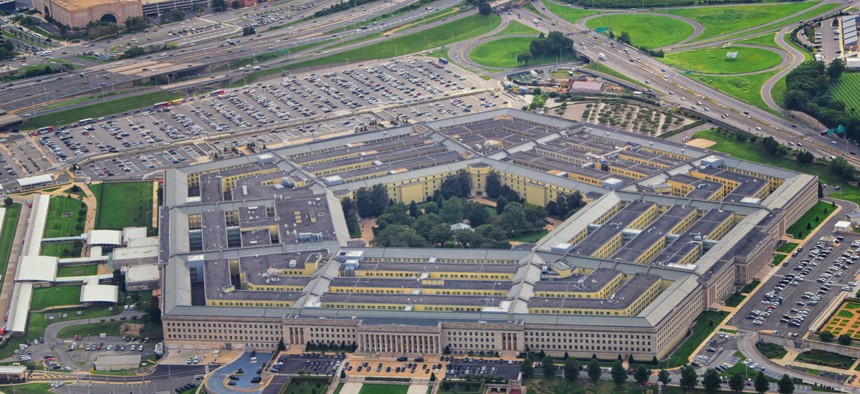Defense Department Details Rapid Increase in Teleworking Capacity That's Here to Stay

Jeremy Christensen/Shutterstock
The department’s vast expansion is thanks to $10.5 billion in funding from the coronavirus stimulus bill.
Even before President Trump signed the $2.3 trillion CARES Act into law, the Defense Department had set off escalating its ability to facilitate remote workers at unprecedented speeds, according to officials who said the new capabilities will remain in place after the pandemic passes.
“The previous pace was one to two years from planning to implementation for such upgrades. Now, they're being completed from days to weeks,” Lt. Gen. BJ Shwedo, director for command, control, communications, and computers/cyber, and chief information officer, Joint Staff, J6, said.
Shwedo briefed reporters Monday along with Defense Department CIO Dana Deasy on some of the ways the department is spending the $10.5 billion it received as part of the stimulus bill.
Some of the new measures, mostly aimed at enabling the workforce to stay home, have also yielded fresh intel about malicious cyber actors exploiting the situation, the officials said, although they would not share details in order to avoid adversaries becoming aware of their insights.
“We’re mitigating [attacks] from the bad guys and learning a lot about them along the way,” Shwedo said. “We're getting better and better at finding their [tactics techniques and procedures] and where these threat vectors are coming from.”
The officials said the department has seen a “surge” in spear phishing, stressing cybersecurity is a key component of their efforts to maximise remote work. A telework task force DoD established in the wake of the pandemic includes U.S. CyberCommand and the National Security Agency.
Deasy said the task force meets daily for about two hours to discuss seven key areas, including “equipment needs, network capacity, operational readiness, IT personnel contracting readiness, supply chain, financial requirements, cybersecurity intel, and high interest items.”
“We've seen unprecedented demand for new equipment ranging from tablets, laptops and network equipment to secure devices,” Deasy said.
Within the Pentagon, 2,000 personnel received additional devices; in the Navy, 65,000 additional users are able to work remotely with mobile and desktop services; the Defense Information Systems Agency, along with a joint service provider, increased virtual internet service provider connections by 30%; and the DOD’s telecom provider increased current call volume capacity in the Pentagon by over 50%, he said.
Deasy added that since the beginning of March, DISA has “on-boarded additional endpoints, increasing capability by over 300%,” and that the US Army has implemented a number of measures that have led to a 400% increase in network access for data and voice capacity.
Altogether, “we have seen upwards of 10 times growth in global video services, outlook web access and enterprise audio conferencing,” Deasy said.
And that capacity isn’t going to go away, the officials said.
“There will be some permanency to what we have here, specifically, more on the network side and we will also have to create a base of teleworking equipment, which we will have to in some cases reuse,” Deasy told reporters. “Yes, there is going to be an enhanced teleworking capability that will be sustained at the end of COVID-19.”
To give an idea of just how much the department’s teleworking capabilities have grown, Shwedo said, before the pandemic, the Navy, for example, could only facilitate 100,000 workers on its network. Now, it can support 250,000, Shwedo said, adding “planned improvements in the next two to three weeks will help bring the total to 500,000 remote users.”
Elsewhere, “within just three days, in March, the Marines increased their [virtual private network] capability from 12,500 to 60,000 simultaneous users,” Shwedo said.
“Our work has enabled productive collaboration for over 4 million military and civilian worldwide teleworkers,” he added.
The investments in telework include ways to facilitate remote work on classified and unclassified networks, officials said.
“Central Command's needs often expand beyond unclassified telework and they needed their capabilities increased for at-home handling of classified information,” they said, noting staff capabilities increased from 261 to 404.
Looking forward, Shwedo said “to enable all these capabilities, we had to do a lot of work, not just procuring laptops and other devices, we also have to manipulate the individual combatant commands on the back end. That doesn't go away and this is going to be a force multiplier for the future case of another pandemic or other worldwide crisis.”
One potential fallout from the DOD’s expansion of teleworking systems concerns the ability to access data it accumulates.
Deasy said data collected from one such system—the Commercial Virtual Remote for which the officials said they have now activated over 900,000 user accounts—would not necessarily be destroyed.
“We recognize that a lot of data is being created,” he said responding to a reporter inquiring about the department’s ability to field related Freedom of Information Act requests. “It's going on to an unclassified environment. I wouldn't say we've concluded right now that we would 'destroy' it. We are looking at options for how do we take this data and preserve it/port it into other collaboration environments going forward. That decision has not been taken. I would not pre-conclude that we've taken a decision the data will flat-out be destroyed.”
RELATED PODCAST






